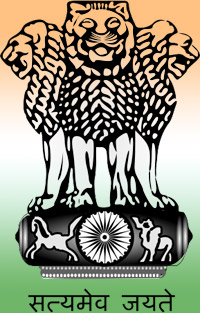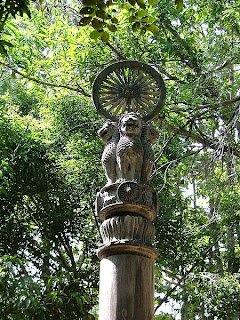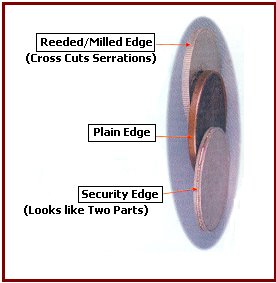Rupee
The Lion capital of Ashoka is a sculpture of four " Asiatic lions (Indian lions)" standing back to back. It was originally placed atop the Aśoka pillar at Sarnath by Emperor Ashoka circa 250 BC. The pillar, sometimes called the Aśoka Column is still in its original location, but the Lion Capital is now in the Sarnath Museum.

Appearance and Making Process
Edges of Coins.
There are four types of edges of coins.
(a) Reeded Edge (Milled Edge, with cross serrations on Rim).
(b) Plain edge (No mark on Rim).
(c) Security Edge (with a deep Indentation on the Rim as if in Two
parts).
(d) Oblique Edge (with serration at an Angle of 30°-45° to the Rim).
Composition of metals used in minting Indian coins
(i) Gold (1835-1918) 91.7% or 22 Carat.
(ii) Standard Silver (1835-1939) 91.7%SiLver+8.3% Copper.
(iii) Silver Alloy (1939-1945) 50%Silver+ 40%Copper+ 5%Nickel+ 5%Zinc.
(iv) Silver Alloy (1969-71) 80%Silver+ 15%Copper+ 5%Nickel.
(v) Silver Alloy (1972-2002) 50%Silver+40% Copper+ 5%Nickel+5%Zinc.
(vi) Copper (1835-1906) Pure Copper.
(vii) Bronze (1906-64) 95-97% Copper+ 4%-21/2%Tin+1.00%;0.50%Zinc.
(viii) Copper-Nickel (1906-2002) 75%Copper+ 25%Nickel.
(ix) Nickel Brass (1964-71) 79%Copper+ 20%Zinc+ 1%Nickel.
(x) Nickel (1946-1974) Pure Nickel.
(xi) Aluminum (1965-93) 96%Aluminium+4% Magnesium.
(xii) Aluminum Bronze (1969-71) 92% Copper+ 2%Nickel+6%Aluminium.
(xiii) Stainless Steel (1988-2002) Ferritic Stainless Steel (Iron 83%,Chromium17%)
Large Denomination
100,000 = 1 Lakh, 100 Lakh = 1 Crore/karor, 100 Crore/karor = 1 Arab ,
India was one of the earliest issuers of coins (circa 6th century BCE). The origin of the word "rupee" is found in the word rūp or rūpā, which means "silver" in many Indo-Aryan languages such as Hindi. The Sanskrit word rupyakam (Devanagari: रूप्यकम्) means coin of silver.
The derivative word Rūpaya was used to denote the coin introduced by Sher Shah Suri during his reign from 1540 to 1545 CE, based on a ratio of 40 copper pieces (paisa) per rupee.
The original Rūpaya was a silver coin weighing 175 grains troy (about 11.34 grams). He also introduced copper coins called Dam and gold coins called Mohur that weighed 169 grains. Among the earliest issues of paper rupees were those by the Bank of Hindostan (1770–1832), the General Bank of Bengal and Bihar (1773–75, established by Warren Hastings), the Bengal Bank (1784–91), amongst others. Until 1815, the Madras Presidency also issued a currency based on the panam, with 12 panams equal to the rupee. Formerly the rupee was divided into 16 annas, 64 paise, or 192 pies. In 15 August 1950 A corn sheaf replaced the Tiger on the one Rupee coin.Indian Rupee sign
The Rupee (abbreviated as Re.(Singular), Rs. (Plural) and now as for Indian rupee symbol). The Indian rupee (Devanagari: रुपया) (sign:  ; code: INR) is the official currency of the Republic of India. The issuance of the currency is controlled by the Reserve Bank of India.
; code: INR) is the official currency of the Republic of India. The issuance of the currency is controlled by the Reserve Bank of India.
The new symbol of the Indian rupee, a mix of the Devanagri ‘Ra’ and Roman ‘R’, was designed by IIT Bombay ,post-graduate D.Uday Kumar. It was approved by the Union Cabinet on July 15, 2010. The parallel lines at the top (with white space between them) are said to make an allusion to the tricolor Indian flag and also depict an equality sign which symbolizes the nation's desire to reduce economic disparity. Ubuntu 10.10 was the first operating system to include this version of Unicode.
After Independence of India, the government brought out the new design Re. 1 note in 1949. Initially it was felt that the King's portrait be replaced by a portrait of Mahatma Gandhi. Finally however, the Lion Capital of Asoka was chosen. In 1953, Hindi was displayed prominently on the new notes.
The "Mahatma Gandhi Series" was introduced in 1996. Prominent new features included a changed watermark, windowed security thread, latent image and intaglio features for the visually handicapped.
Lion capital of Ashoka
Emperor Ashoka the Great erected the capital atop an Ashoka Pillar to mark the spot where Gautama Buddha first taught the Dharma and where the Buddhist Sangha was founded.
The Lion capital of Ashoka is a sculpture of four " Asiatic lions (Indian lions)" standing back to back. It was originally placed atop the Aśoka pillar at Sarnath by Emperor Ashoka circa 250 BC. The pillar, sometimes called the Aśoka Column is still in its original location, but the Lion Capital is now in the Sarnath Museum.
This Lion Capital of Ashoka from Sarnath has been adopted as the National Emblem of India and the wheel "Ashoka Chakra" from its base was placed onto the center of the National Flag of India.
The capital contains four lions (Indian / Asiatic Lions), standing back to back, mounted on an abacus, with a frieze carrying sculptures in high relief of an elephant, a galloping horse, a bull, and a lion, separated by intervening spoked chariot-wheels over a bell-shaped lotus.
Carved out of a single block of polished sandstone, the capital was believed to be crowned by a 'Wheel of Dharma' (Dharmachakra popularly known in India as the "Ashoka Chakra"), which has now been lost. There is a similar intact Ashoka pillar in Thailand with a similar four lion capital intact and crowned with Ashoka Chakra / Dharmachakra.
The four lions (one hidden from view) - symbolising power, courage, pride and confidence - rest on a circular abacus. The abacus is girded by four smaller animals - guardians of the four directions: the lion of the north, the elephant of the east, the horse of the south and the bull of the west. The abacus rests on a lotus in full bloom, exemplifying the fountainhead of life and creative inspiration.
Forming an integral part of the emblem is the motto inscribed below the abacus in Devanagari script: Satyameva Jayate सत्यमेव जयते (English:Truth Alone Triumphs). This is a quote from Mundaka Upanishad, the concluding part of the sacred Hindu Vedas.
It was adopted as the National Emblem of India on 26 January 1950, the day that India became a republic.

The emblem forms a part of the official letterhead of the Government of India, and appears on all Indian currency as well. It also sometimes functions as the national emblem of India in many places and appears prominently on the diplomatic and national Passport of the Republic of India. The wheel "Ashoka Chakra" from its base has been placed onto the center of the National Flag of India
Rupee Used in other country
The rupee is the common name for the monetary unit of account in India, Sri Lanka, Nepal, Pakistan, Mauritius, Seychelles, Indonesia, Maldives, and formerly in Burma, and Afghanistan.
The Indian rupee was the official currency of Dubai and Qatar until 1959, when India created a new Gulf rupee (also known as the "External rupee") to hinder the smuggling of gold. The Gulf rupee was legal tender until 1966, when India significantly devalued the Indian rupee and a new Qatar-Dubai Riyal was established to provide economic stability.
The Gulf rupee, also known as the Persian Gulf rupee (ISO 4217 code: XPGR), was a currency used in the countries of the East Africa , Persian Gulf (Kuwait, Bahrain, Qatar, the Trucial States (UAE),oman and in parts of Muscat) and the Arabian Peninsula between 1959 and 1966. It was issued by the Government of India and the Reserve Bank of India Amendment Act, 1 May 1959. and was equivalent to the Indian rupee.
Appearance and Making Process
Edges of Coins.
There are four types of edges of coins.
(a) Reeded Edge (Milled Edge, with cross serrations on Rim).
(b) Plain edge (No mark on Rim).
(c) Security Edge (with a deep Indentation on the Rim as if in Two
parts).
(d) Oblique Edge (with serration at an Angle of 30°-45° to the Rim).
During the period 1835-2002, coins with first three types of edges have been issued.
Technique Of Minting Coins.
There are four methods of Minting Coins
(i) Punch Marked
(ii) Casting
(iii)Repousse
(iv) Die-Struck (Milled)
Since nineteenth century, the die-struck milled method is being followed in every country.
Machine minted coins have better finish, the labour cost is much reduced and output is manifold. In 1790, the above machines were brought from England, and manufacturing of Milled Coins started at Calcutta.
Composition of metals used in minting Indian coins
(i) Gold (1835-1918) 91.7% or 22 Carat.
(ii) Standard Silver (1835-1939) 91.7%SiLver+8.3% Copper.
(iii) Silver Alloy (1939-1945) 50%Silver+ 40%Copper+ 5%Nickel+ 5%Zinc.
(iv) Silver Alloy (1969-71) 80%Silver+ 15%Copper+ 5%Nickel.
(v) Silver Alloy (1972-2002) 50%Silver+40% Copper+ 5%Nickel+5%Zinc.
(vi) Copper (1835-1906) Pure Copper.
(vii) Bronze (1906-64) 95-97% Copper+ 4%-21/2%Tin+1.00%;0.50%Zinc.
(viii) Copper-Nickel (1906-2002) 75%Copper+ 25%Nickel.
(ix) Nickel Brass (1964-71) 79%Copper+ 20%Zinc+ 1%Nickel.
(x) Nickel (1946-1974) Pure Nickel.
(xi) Aluminum (1965-93) 96%Aluminium+4% Magnesium.
(xii) Aluminum Bronze (1969-71) 92% Copper+ 2%Nickel+6%Aluminium.
(xiii) Stainless Steel (1988-2002) Ferritic Stainless Steel (Iron 83%,Chromium17%)
Large Denomination
100,000 = 1 Lakh, 100 Lakh = 1 Crore/karor, 100 Crore/karor = 1 Arab ,
100 Arab = 1 Kharab/khrab, 100 Kharab/khrab = 1 Neel, 100 Neel = 1 Padam,
100 Padam = 1 Rajam, 100 Rajam = 1 Uroos, 100 Uroos= 1 Zahra and Ammar





No comments:
Post a Comment
Note: Only a member of this blog may post a comment.